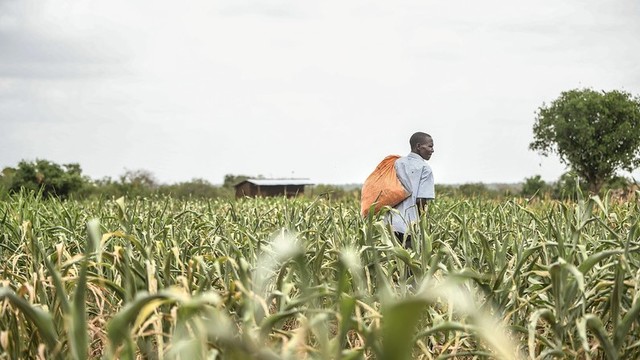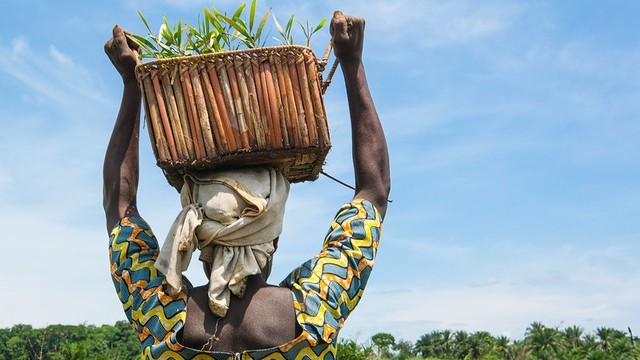Indigenous Peoples, local communities underrepresented in governance of nature funding
Indigenous Peoples and local communities are critical to protecting nature. Yet new research reveals they occupy only 11% of seats on boards of 16 funds that collectively aim to provide more than US$2 billion in nature funding to them. Indigenous Peoples and local communities need more representation at the highest level to better influence how this funding is spent, which remains an unresolved issue at COP15 talks in Montreal this week.

Indigenous Peoples and local communities, governments, intermediaries and NGOs join a nature finance roundtable at COP15 hosted by the IIFB and IIED (Photo: Nicola Sorsby, IIED)
Indigenous Peoples and local communities are the rightful owners of many biodiverse territories. Their stewardship – informed by deep traditional, Indigenous and cultural knowledge and connection to the land – makes a substantial but undervalued contribution to conservation outcomes.
For many years, Indigenous Peoples and local communities have repeatedly called out the challenges of accessing sufficient funding to support their priorities and of ensuring they have meaningful influence over how that funding is designed, delivered and implemented. We captured many of these concerns in a blog earlier this year.
The 15th Conference of the Parties (COP15) to the Convention on Biological Diversity in Montreal has only a week to go. After a two-year delay due to COVID-19, there is high anticipation that COP15 will land an ambitious ten-year global biodiversity framework (GBF) (PDF) that will give biodiversity its ‘Paris Agreement’ moment and put in place the building blocks to transform our relationship with nature.
Draft negotiation text doesn’t go far enough
Countries have yet to reach agreement on how to design and deliver the proposed $200 billion a year to implement the GBF. Importantly, the draft GBF text currently recognises the need to ensure this finance is accessible and transparent and that direct access modalities are in place for Indigenous Peoples and local communities.
These commitments must remain in the final agreed framework. But the draft text stops short of ensuring Indigenous Peoples and local communities are part of meaningful and equitable governance arrangements that would enable them to influence the design, delivery and implementation of the finance according to their self-determined needs and priorities. These points must be resolved, and new research reveals there is a long way to go.
Indigenous Peoples and local communities underrepresented on governance boards
While much of the negotiations have focused on the volume of funding needed to implement the GBF, there has been much less focus on the longer-term predictability of this funding, how it should be delivered, ensuring it is accessible and that the priorities are shaped by Indigenous Peoples and local communities.
Compelling recent research has shone light on this. An analysis by the Rights and Resources Initiative and Rainforest Foundation Norway showed that, of the $270 million in conservation funding invested annually in tenure and forest management initiatives of Indigenous Peoples and local communities, just 17% went to activities that specifically named an Indigenous Peoples and local communities' organisation.
The International Indigenous Forum on Biodiversity (IIFB) and IIED are investigating how well Indigenous Peoples and local communities are represented on governance boards. We undertook desktop research of publicly available information on the governance arrangements of 16 boards that specifically aim to deliver more than $2 billion in nature funding to Indigenous Peoples and local communities. Our preliminary findings are concerning:
- Representatives from Indigenous Peoples and local communities occupy on average only 11% of the seats on the core governance boards of 16 funds that aim to deliver more than $2 billion to Indigenous Peoples and local communities
- The majority of the governance boards had one or no seats for Indigenous Peoples and local communities – however some funds stood out for being more inclusive, with one board having up to 88% of their board seats occupied by Indigenous Peoples and local communities, and
- Fewer than half of the 16 funds appear to have an Indigenous Peoples and local communities advisory board to inform their core governance board.
These findings show that Indigenous Peoples and local communities have limited power at the highest levels of fund decision-making, even when the funds are specifically meant for Indigenous Peoples and local communities. The research also highlights significant transparency challenges, with some of the publicly available information on fund governance arrangements very difficult to find. Further findings on the 16 funds and the scope and influence of the Indigenous Peoples and local communities seats will be published in 2023, along with the full research methodology.
Of course, simply having a seat on a governance board doesn’t immediately equal power and influence. Shifting the balance of power, from protected areas governed mainly by government agencies, the private sector and large NGOs towards Indigenous Peoples and local communities requires equitable governance at all levels – from global to local.
A broken funding system
This research is the latest to show that what Indigenous Peoples and local communities already know: that the current funding system is not working for them. Indigenous Peoples and local communities continue to raise multiple challenges, including:
- Limited direct influence by Indigenous Peoples and local communities over how funding for them is prioritised at the highest level of decision-making – which means the activities and expected outcomes of the funding has already been determined by the time it reaches Indigenous Peoples and local communities
- Accessing the funds directly is difficult due to challenges with finding information online or complicated eligibility requirements, which locks in reliance on partners and intermediaries who continue to develop their expertise
- Low transparency and accountability in delivery against nature finance commitments by governments and funds, which makes it very difficult to track the flow of money, and
- The detrimental practice of delivering the finance through intermediaries which perpetuates the colonial construct that Indigenous Peoples and local communities are not capable of managing funds and falsely builds the image that Indigenous Peoples and local communities are passive beneficiaries of external decision-making, never full actors.
Many of these issues are consistent with Indigenous Peoples and local communities' experiences in accessing climate finance too. There is a need to reform the nature and climate finance system; COP15 represents a key moment to facilitate this.
Global biodiversity framework: a new hope or business as usual?
As negotiations go down to the wire this week, goal D and targets 18 and 19 in the GBF must lock in an ambitious global quantitative finance goal and emphasise the need for longer-term and predictable funding. Further, the GBF must require the funding to be accessible to Indigenous Peoples and local communities and designed, delivered and implemented through equitable governance arrangements where Indigenous Peoples and local communities have strong and meaningful influence.
This is critical to many other elements of the GBF too, including target 3, which aims to protect 30% of the Earth’s land and sea by 2030.
Unless the GBF commits to Indigenous Peoples and local communities to be at the heart of decision-making in how nature finance and resources are used, the implementation of the GBF will be undermined and the potential to reverse our damaging relationship with nature will hang in the balance.






